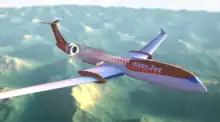Wright Electric
Wright Electric is an American startup company developing an electric airliner.
 | |
| Type | Private |
|---|---|
| Industry | Aerospace |
| Founded | 2016 |
| Headquarters | Albany, NY, U.S. |
Key people | Jeff Engler (CEO) |
| Products | Electric aircraft |
| Website | weflywright |
Design
The aircraft is to run on batteries and handle flights of under 300 miles.[1] It will feature high aspect-ratio wings for energy efficient flight, distributed electric propulsion and swappable battery packs with advanced cell chemistry.[2]
History
The 10-person Los Angeles based startup was founded in 2016 and has received venture capital from groups such as Silicon Valley accelerator Y Combinator.[3] The company is named after the Wright brothers.[4]
In September 2017, UK budget carrier EasyJet announced it was developing an electric 180-seater for 2027 with Wright Electric.[5] Wright Electric built a two-seat proof-of-concept with 272 kg (600 lb) of batteries, and believes that batteries can be scaled up with substantially lighter new battery chemistries: a 291 nautical mile (540 km) range would suffice for 20% of Easyjet passengers.[6] Wright Electric plans to develop a 10-seater and eventually an at least 120 passengers single-aisle, short-haul airliner and targets 50% lower noise and 10% lower costs.[7]
To evaluate electric propulsion systems, two test stands were constructed: one with two 250 kW UQM motors and two Hartzell Propellers, built with Yates Electrospace, the other on a 10,000 lb (4,500 kg) trailer to be brought to high altitude test sites.
In May 2018, Jetex, a Dubai fixed-base operator with 30 bases, invested in the company.[8][9]
By November 2018, Wright was testing a commercially available electric motor, before combining it with a Pratt & Whitney Canada PT6A turboprop to be installed on an existing nine-seater for 2019 flight tests, which may be marketed subsequently. Wright is working with Madrid-based Axter Aerospace, already flying its two-seat AX-40S based on a Tecnam P92 with a Rotax piston engine and an electric motor driving the propeller, with four times less power. After a 50-seat model, Darold Cummings, designer of the ESAero ECO-80 turboelectric configuration for NASA, evolved this previous design for the Wright 186-seat airliner with 500 km (270 nm) of range for Easyjet, which could use a more powerful Wright-patented motor.[10]
By November 2019, test flights of the nine-seater were to begin in the coming weeks, while EasyJet partnered with Airbus to study a short-haul airliner concurrently.[11]
In January 2020, Wright Electric revealed that it was constructing a 1.5 MW electric motor and 3 kV inverters intended to power a 186-seat Wright 1 aircraft with a range of at least 300 nmi (560 km) that could enter into service from 2030. Ground testing of the motor is planned for 2021 and flight testing for 2023.[12]
Wright Electric has been granted the Sustainability Award 2020 by World Finance as the world's most sustainable organisation in the aircraft manufacturing industry.[13]
In September 2021, Wright Electric started testing a 2 MW (2,700 hp) electric motor for its 800 nmi (1,500 km) range, 186-passenger Wright 1 airliner to enter service in 2030, partnering with EasyJet and Viva Aerobus.[14] In November 2021, the company announced an all-electric version of the BAe 146 regional jet for a 2024 first flight and a 2026 introduction, replacing its four turbofans with electric motors for an hour of endurance, with power coming from aluminum or hydrogen fuel cells.[14]
See also
References
- Josh Constine (Mar 21, 2017). "Wright Electric unveils its commercial electric plane business". TechCrunch.
- "Wright Electric".
- Samantha Masunaga (Sep 27, 2017). "This L.A. electric plane startup is working with EasyJet to develop electric jetliners". LA Times.
- Engler, Jeffrey (2015-09-17). "WRIGHT WEEKLY WEPORT SEPT 17 2015". Wright Electric blog.
- Victoria Moores (Sep 27, 2017). "EasyJet joins electric aircraft project". Aviation Week Network.
- Dominic Perry (27 September 2017). "EasyJet unveils short-haul electric aircraft ambition". Flightglobal.
- Monaghan, Angela (27 September 2017). "EasyJet says it could be flying electric planes within a decade". The Guardian. Retrieved 28 September 2017.
- Murdo Morrison (25 May 2018). "Jetex to help power up electric aircraft developer". Flightglobal.
- "Electric Aircraft – The Future of Aviation Sustainability". FBO Networks, Ground Handling, Trip Planning, Premium Jet Fuel. 2019-06-24. Retrieved 2023-03-14.
- Graham Warwick (Nov 5, 2018). "The Week In Technology Nov. 5-Nov. 12, 2018". Aviation Week & Space Technology.
- Michael Gubisch (19 Nov 2019). "Airbus and EasyJet to jointly study electric aircraft". Flightglobal.
- Kaminski-Morrow, David (30 January 2020). "EasyJet 'electric aircraft' partner aims to fly engine in 2023". Flight Global.
- "Sustainability Awards 2020". World Finance. 3 July 2020.
- Charles Alcock (November 4, 2021). "Wright Takes BAe 146 Fast-Track to Electric Airliner Market". AIN.